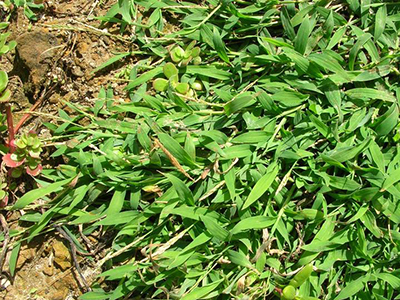Crabgrass

Southern crabgrass (Digitaria ciliaris). Photo by Forest and Kim Starr, Starr Environmental, Bugwood.org.
As winter stretches on, you may find yourself with brown lawn areas that you swear were healthy green turf a few months ago. If so, the culprit is likely crabgrass. This grassy, warm-season weed can't take the cold, but it will most likely return.
An important part of preventing crabgrass and other weeds from taking over your lawn is maintaining healthy turf. Choosing the right type of grass for a site is the first step in insuring a healthy lawn. Be sure to mow your lawn to the proper height and mow often, so that you are only removing 1/3 of the leaf blade. Thick, healthy turf minimizes the spaces where weeds can become established and blocks sunlight that weed seeds need to germinate.
Unfortunately, once crabgrass has germinated and begins to grow, there are very few or no herbicides available to homeowners or commercial applicators that can kill it without harming most types of turfgrass grown in Florida.
The best way to manage crabgrass is to get ahead of it with a pre-emergent herbicide. Dithiopyr, pendimethalin, and prodiamine (among several others) are common pre-emergent herbicides that are widely available to homeowners and can be used to stop crabgrass from emerging. All of these products are sold under a variety of different trade names, so it is important to read herbicide labels and be familiar with the active ingredients you are using.
The downside is that there is a narrow window of time to apply crabgrass herbicides for best results. That window depends on where you live in Florida. The general rule of thumb is to apply pre-emergent herbicides in early February for South Florida, mid-February for Central Florida, and early March for North Florida. You want to apply the pre-emergent herbicide before temperatures consistently rise above 65 to 70°F to avoid harming your grass.
Note that you should not use pre-emergent herbicides on areas where you plan to put down new sod or grow turfgrass from seed. A good general rule is to wait two to four months between the last use of pre-emergent herbicides and the planting of new sod, but it is always important to consult product labels before using any product on your lawn.
Read the entire herbicide label before making any application and pay special attention to any ornamental species that are listed as “do not treat” or should be avoided so that they are not treated or contacted inadvertently with the herbicide during an application to the turf. Also, it is generally recommended that you shouldn't use a pre-emergent herbicide paired with a fertilizer ("weed and feed"). The right time of year for applying a pre-emergent lawn herbicide can be the wrong time for lawn fertilizing.
Also on Gardening Solutions
UF/IFAS Sites
UF/IFAS Publications
Special thanks to Dr. Chris Marble, Assistant Professor in Ornamental and Landscape Weed Management at the Mid-Florida Research and Education Center.

